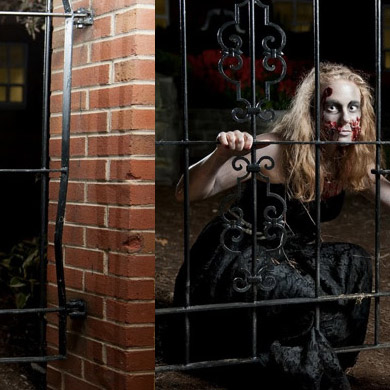Pushing the envelope in higher education is not always easy, so imagine the challenge when you want to transform the envelope into a zombie that wants to eat your students’ brains.
For April Fools’ Day 2011, we made a last minute decision to swap one of our standard student-profile photos on the homepage for a picture of “Hazel the Squirrel.” For months afterwards, people would ask me and my staff, “Are you guys responsible for the squirrel? Awesome! How are you going to top that?” How indeed?

Fast-forward six months to Halloween, when we replaced all four of the student profiles with profiles of student “monsters”; posted a video profiling each monster along with faculty and staff interviews; and created a behind-the-scenes video showing the transformation of the students into monsters.
So how did we make it happen? And even more importantly, how did we convince people we should? Three things were key:
It’s in the pitch
Rather than selling administrators on a “silly project” that would make people laugh, we created a plan that would showcase the work of our theatre students and give them a chance to try out their skills under relatively “real world” conditions. We approached the professor who taught the makeup classes and asked her to pick some students to work with us on the project. The students “pitched” their ideas to us as though we were clients and then spent between 60 and 90 minutes each transforming their classmates into ghoulish monsters. Selling this endeavor as a learning opportunity for students was essential to persuading people to support it. (And it didn’t hurt that we had several advocates with great senses of humor!)
Keep it secret
Other than a few key administrators and the people directly involved in the project, no one else on campus was made aware of the project. Keeping the circle of knowledge focused on only those who needed to know prevented the inevitable devil’s advocate from raising unfounded concerns just because he or she could. That’s not to say that as the project moved forward there weren’t concerns. In fact, at one point we had a rousing discussion about whether monsters lived under beds or in closets. However, sometimes people raise concerns just because they can, so limiting the number of people involved helped keep that to a minimum.
Do it well
We began working on the project in early September, realizing that a project like this would draw a lot of attention. It was essential that if we wanted to pull this off, we had to do it right; otherwise, no one would trust us to think outside the box again.
The project’s goal was to showcase student work, raise the profile of the university and lighten the mood mid-semester. How did we do?
As a former media relations director, I always start with the media coverage. I was thrilled when the Washington Post did a story giving us kudos to our new approach to profiling diversity. And I jumped at the chance to be interviewed by the local CBS affiliate. In one day, we had more than 1,800 views of our profile video and 2,500 views of the behind-the-scenes video. We received 2.28 times the amount of homepage traffic we normally receive, and were tweeted and retweeted so many times I lost count. Overall, we received more than 70 positive comments while just two students weighed in that they didn’t like it.
My favorite piece of feedback was from the Dean of the College of Visual and Performing Arts. He got it: “Although this is seen as humorous on the surface, it ‘screams’ volumes about our campus.”
The next question is, how are we going to top this?
[field name=code]


One reply on “BRAAAAAINS! Or, How Radford’s Halloween Web Project Made the Washington Post”
I love this! I saw it on the day and thought it was so amazing since — as you say — it wasn’t just funny (though it was) but it also tied in to your message about Radford students. And now that I see how the students were involved in pulling it off? That is scary good!